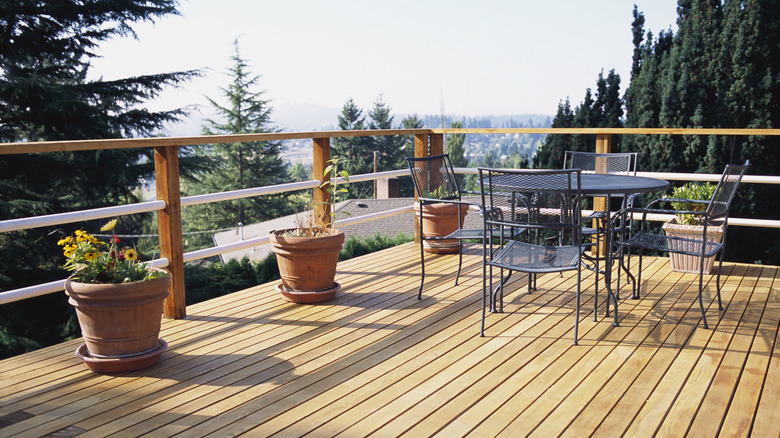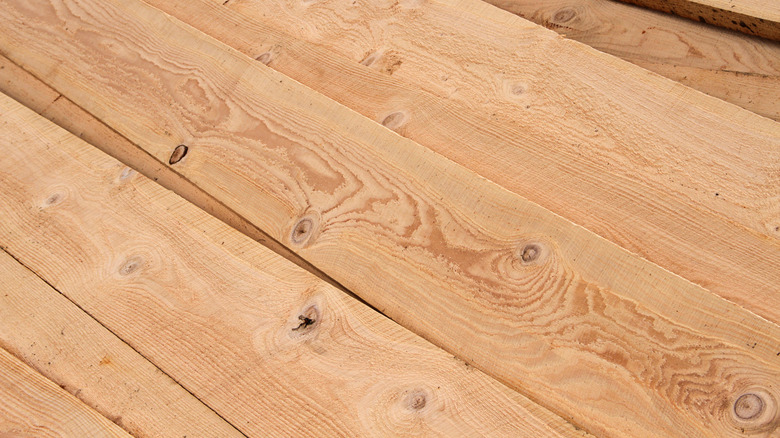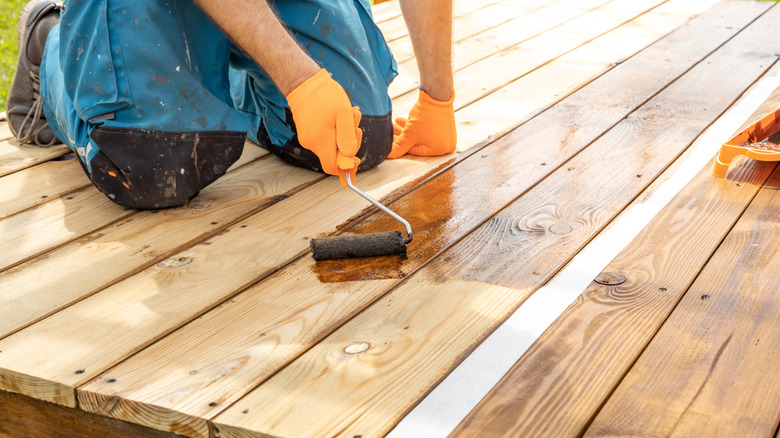The Affordable Outdoor Wood Decking Material That Comes With Major Downsides
At an average price of around $8,000, installing a deck isn't exactly cheap. Many homeowners must make compromises to make it happen, and using the most affordable lumber can seem like a straightforward way to bring your DIY deck plans to life. But one affordable wood decking material comes with major downsides, like a tendency to splinter, high maintenance requirements, and a lack of resistance to rot and insects: hem-fir.
Hem-fir is actually two types of wood: western hemlock and any one of several true fir types, such as noble, white, or grand fir. These trees are so similar to each other that lumber mills process them together; a stack of hem-fir is really a mix of hemlock boards and fir boards. The wood is light in color, evenly textured, and fine-grained. Untreated hem-fir is among the most affordable wood that you can use for decking aside from pallet wood. It's also easy to find at home improvement stores or lumber yards.
But when choosing a wood decking material, cost is only one part of the picture. It's just as important to consider the workability of the wood, strength, maintenance requirements, insect and rot resistance, and aesthetics. Hem-fir excels in strength, workability, and aesthetics, but it isn't as strong of a contender when it comes to maintenance and resistance. Still, you can make this material work for you by choosing the right type of hem-fir and taking the proper precautions.
Untreated hem-fir is especially risky
There are two categories of real wood to choose from when designing your deck: hardwood and softwood. Hardwoods such as ipe and jatoba are strong, durable, and naturally resistant to decay and insects. Softwoods, which include hem-fir as well as pine, are less expensive but don't have that natural resistance. They're commonly pressure-treated, a method in which preservatives, insecticides, and fungicides are added to the wood to make it last longer. You can save more money by opting to buy untreated hem-fir, and that's where the major downsides come into play.
Since untreated hem-fir can't effectively resist damage from insects, fungi, moisture, or sunlight, it's vulnerable to a range of problems, from mold to cracks to splinters. If left to the elements, your deck can start to show signs of mold within six months and eventually become unusable. The number one thing to do to protect your wood deck is to apply your own preservative or a primer and paint. You'll need to spend more time maintaining the deck if you use untreated hem-fir compared to pressure-treated wood or hardwood.
On the bright side, hem-fir is easy to seal. Make sure to find the perfect amount of time to wait before sealing your wooden deck — the wood must be dry enough to accept the finish, but not so dry that it has begun to experience wear and tear. A solid-color preservative will offer the most protection and require the least frequent reapplications, but it will change the appearance of the wood. More transparent stains offer less protection and require more reapplications (think every year or two). Ideally, you should also apply a water-repellent and UV-protectant finish.
What about pressure-treated hem-fir?
Hem-fir is easily pressure-treated, and this is a far safer option than untreated hem-fir; it's still very affordable and is worth the extra cost. Indeed, most hem-fir used in outdoor decking is pressure-treated, as this process helps softwood decks last decades longer. Still, pressure-treated wood isn't perfect either.
The preservation process makes the wood more vulnerable to splitting and splintering, which can be a safety hazard and require extra maintenance. And while it's protected from natural decay, insects, and fungi, it's still vulnerable to moisture and sunlight. To prevent warping or cracking, you'll need to apply an additional water-repellent preservative to the wood as soon as it's dry enough to accept the product after installation (unless it won't be exposed to the rain). This sealer needs to be reapplied every year or two, depending on the product. Additionally, it's best to apply a sealing preservative to the cut ends of the wood.
Pressure-treated wood provides protection from decay and saves you from the extra step of re-preserving your deck regularly. Regular cleaning will keep your deck in even better shape and mold- and mildew-free. Avoid using bleach to clean treated wood; instead, use hydrogen peroxide or oxygen bleach.


